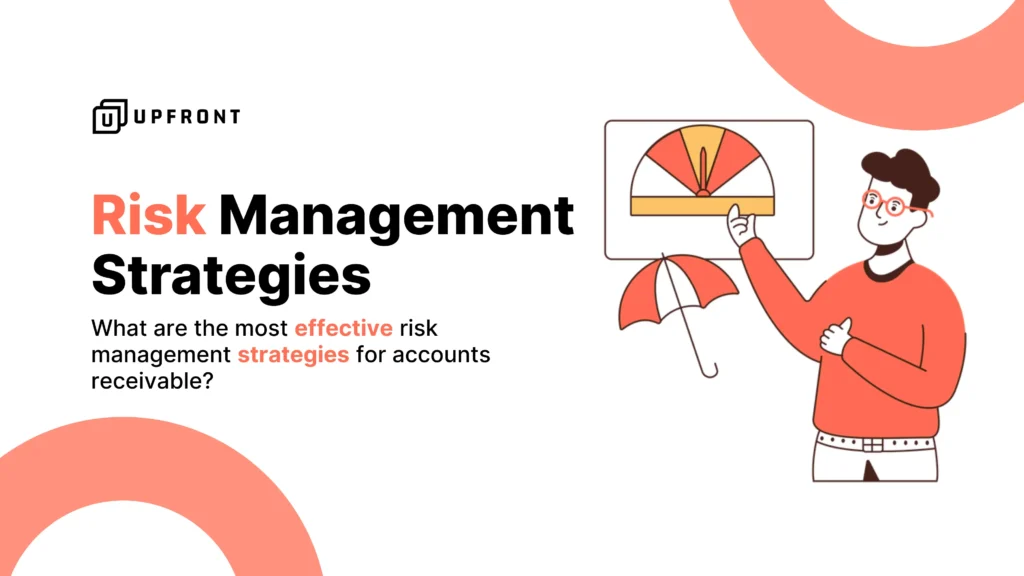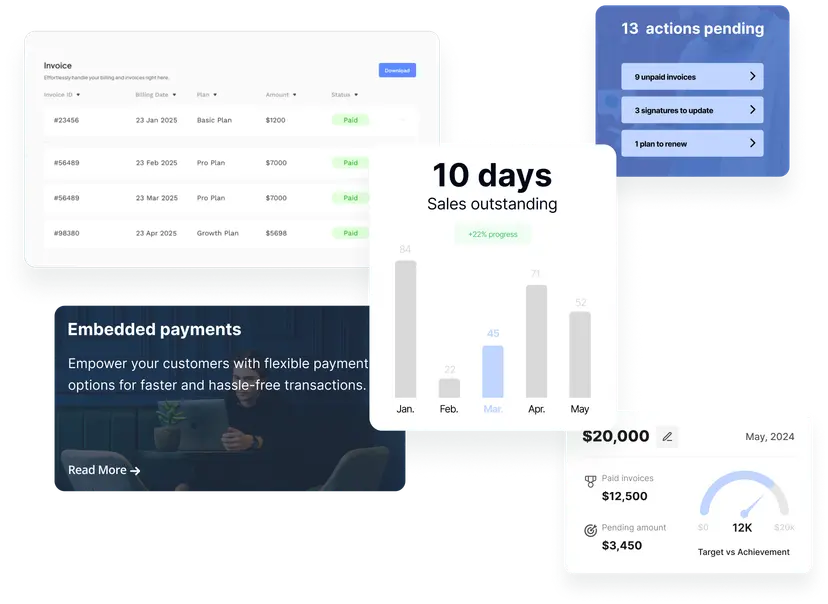What are the most effective risk management strategies for accounts receivable?
The best approaches include automating AR processes to reduce errors, monitoring customer credit in real time, sending timely payment reminders, segmenting customers for targeted credit controls, and conducting regular risk assessments.
These risk management strategies help minimize late payments, reduce bad debt, and maintain healthy cash flow Looking for the most effective risk management strategies to reduce financial risk, optimize cash flow, and prevent late payments? Explore how accounts receivable automation streamlines AR processes, boosts cash flow, and strengthens your overall risk management framework.
This comprehensive guide delivers actionable risk management strategies, expert tips, and the latest insights on using AR automation to manage financial risk and drive business performance.
What is Risk Management?
Risk management involves identifying, analyzing, and addressing potential disruptions that could impact a business. These risks can stem from financial uncertainties, operational breakdowns, legal issues, or even customer-related challenges.
For businesses, effective risk management ensures long-term growth, stable cash flow, and the ability to withstand market fluctuations.
Types of Business Risks
- Financial Risks: Late payments, cash flow shortages, credit defaults—all mitigated through targeted risk management strategies.
- Operational Risks: Manual entry errors and system failures addressed by automation-based risk management.
- Compliance Risks: Automated tracking ensures regulatory compliance as part of a comprehensive risk management approach.
- Strategic Risks: Informed financial decisions and growth, enabled by data-driven risk management strategies.
Implementing robust strategies to manage these risks allows businesses to focus on achieving their goals while minimizing adverse impacts.
Effective Risk Management Strategies
1. Establish a Comprehensive Risk Assessment Framework
Begin by identifying potential risks. Break them into categories such as financial, operational, and compliance risks, then evaluate their likelihood and potential impact. Tools like risk assessment matrices or accounts receivable risk analysis software can help prioritize areas needing immediate attention.
2. Focus on Financial Risk Management for Stability
Proactive financial risk management safeguards your revenue and cash flow. Implement these measures to protect your bottom line:
- Credit Risk Management – Assess the creditworthiness of customers before extending credit terms. Automate credit checks for customers using advanced tools to streamline this process.
- Accounts Receivable Risk Mitigation – Use AR automation to monitor outstanding invoices, flag overdue payments, and streamline collections.
- Late Payment Prevention – Introduce clear payment terms and incentivize early payments to reduce payment risk in B2B transactions.
3. Adopt Automation Tools for Greater Efficiency
Automation plays a pivotal role in modern risk management initiatives. By leveraging automated solutions in accounts receivable (AR), businesses reduce human error, enhance accuracy, and speed up risk detection. For instance:
- AR Analytics & Forecasting Dashboards provide real-time insights into expected cash inflows.
- Automate Credit Checks for Customers to instantly gauge creditworthiness and reduce onboarding risks.
- Late Payment Recovery Tools enable faster resolution of overdue invoices.
4. Implement Effective Credit Control Strategies
Maintain strict oversight of credit policies to avoid undue exposure. Consider the following best practices:
- Regularly monitor customer payment behavior.
- Segment customers based on risk levels.
- Use customer credit risk automation systems to evaluate and adjust credit terms dynamically.
5. Integrate Accounts Receivable Automation
Manual workflows are prone to delays and inaccuracies. Transition to AR automation to:
- Reduce DSO (Days Sales Outstanding)—a critical metric for cash flow optimization.
- Monitor outstanding payments efficiently.
- Automatically follow up with reminders to minimize late payments.
By using tools that provide real-time visibility into receivables, businesses can optimize cash flow while mitigating risks.
Best Risk Management Strategies for Accounts Receivable Automation
1. Conduct Regular AR Risk Assessments
Evaluate your financial, operational, and compliance risks using AR automation platforms. Modern accounts receivable risk management tools provide automated risk identification and prioritization, ensuring you focus on the biggest threats to cash flow.
2. Automate Credit Risk Management for Stronger Cash Flow
- Automated Credit Checks: Quickly assess customer creditworthiness with AR automation solutions.
- Credit Risk Monitoring: Continuously monitor for changes that can increase late payment risk.
- Streamline AR Processes: Automate invoice generation, payment reminders, and collections to prevent cash flow delays.
3. Minimize Late Payment Risks with Automated Systems
- Automatic Payment Reminders: Reduce late payment risk by sending scheduled reminders.
- Real-Time Analytics: Leverage analytics dashboards for instant insight into AR performance and late payment trends.
- Automated Collections: Quickly act on overdue invoices to optimize cash flow.
Upfront’s AR automation platform offers powerful features designed for financial risk reduction and cash flow optimization.
4. Smart Customer Segmentation and Dynamic Credit Control
- Use AR automation to segment customers by payment behavior and risk profile.
- Dynamically adjust credit limits based on up-to-date data.
- Monitor risk in real time to protect against late payment risks and maintain healthy cash flow.
5. Improve Collections and Reduce DSO with Automation
- AR automation significantly reduces Days Sales Outstanding (DSO).
- Get full AR visibility through real-time dashboards.
- Automate payment reminders and collections for faster cash flow optimization.
UPFRONT can help you manage accounts receivable risk, minimize late payment risk, and maintain healthy cash flow.
FAQs on Risk Management
What are the main risk management strategies in business?
The key strategies include:
- Conducting regular risk assessments.
- Managing financial risks through credit monitoring and payment controls.
- Automating essential processes to reduce errors and improve efficiency.
- Continuously monitoring and reviewing risk mitigation efforts.
How do you manage credit risk in accounts receivable?
Effective credit risk management involves conducting initial and periodic credit checks on customers, setting appropriate credit limits, and using automation to monitor and flag overdue payments. These efforts ensure tighter control over receivables.
What is the role of AR automation in reducing financial risk?
AR automation provides real-time visibility into cash flow, ensures timely action on overdue payments, and reduces human-related errors. This enhances financial stability and minimizes risks associated with delayed receivables.
How can businesses reduce late payment risks?
To reduce late-payment risks, businesses can:
- Establish clear terms and conditions for payments upfront.
- Use automation tools for invoice tracking and reminders.
- Offer early payment discounts or impose late penalties as deterrents.
What tools help automate credit and payment risk management?
Tools like predictive AR analytics, automated credit scoring software, and late payment recovery platforms help streamline credit and payment risk management processes.
How does automating accounts receivable improve risk control?
Automation enhances risk control by providing accurate, real-time reporting, ensuring timely follow-ups with late payers, and offering actionable insights into cash flow and outstanding receivables.
Can small businesses automate risk management in AR?
Yes! Many scalable and affordable AR automation tools are tailored for SMEs. These solutions simplify processes like credit checks, payment tracking, and cash flow forecasting.
What are the best strategies for accounts receivable risk management?
- Use AR automation for ongoing risk assessments and monitoring
- Automate credit checks and payment reminders
- Integrate analytics to spot cash flow risks early
- Continuously update risk mitigation practices
How does accounts receivable automation reduce late payment risks?
AR automation gives you instant visibility into outstanding invoices, enables proactive follow-ups, and reduces the chance of late payments slipping through the cracks.
Can small businesses benefit from AR automation for cash flow optimization?
Yes. Scalable AR automation solutions, like Upfront, help small and medium-sized businesses manage credit, automate collections, and reduce late payment risks to improve cash flow.
Which AR automation features help minimize financial risk?
- Automated invoicing and payment reminders
- Predictive analytics for late payment risk
- Real-time risk monitoring and reporting dashboards
Strengthen Your Business with Accounts Receivable Automation for Maximum Financial Risk Reduction
Financial risk reduction is ongoing—but deploying accounts receivable automation is the most powerful way to lower late payment risk, boost cash flow, and strengthen your company’s financial resilience.
UPFRONT’s robust AR automation solutions deliver scalable, actionable risk management for companies at every growth stage. Take control of your accounts receivable, accelerate cash flow, and minimize financial risks—launch your AR automation transformation with UPFRONT today.
Next to Know → Growth blueprint: Strategic Financial Decisions → Cycle acceleration: Improve Cash Conversion → Capital strategy: Investment Strategies → Risk shield: Risk Management Strategies → Liquidity engineering: Cash Flow Optimization






